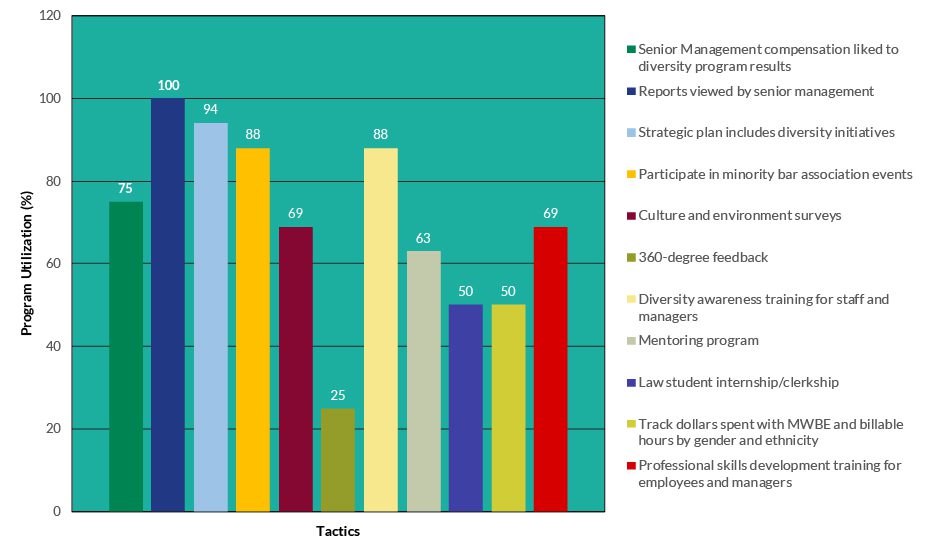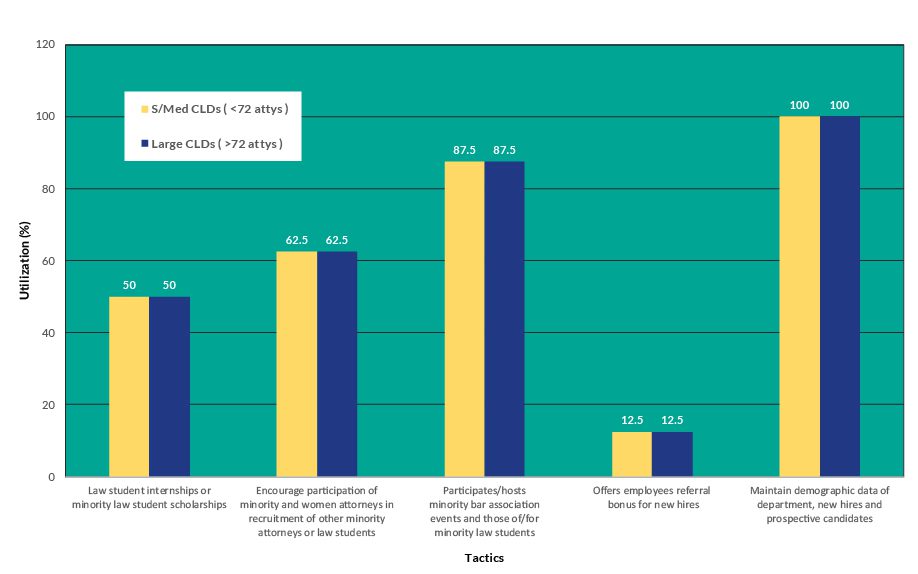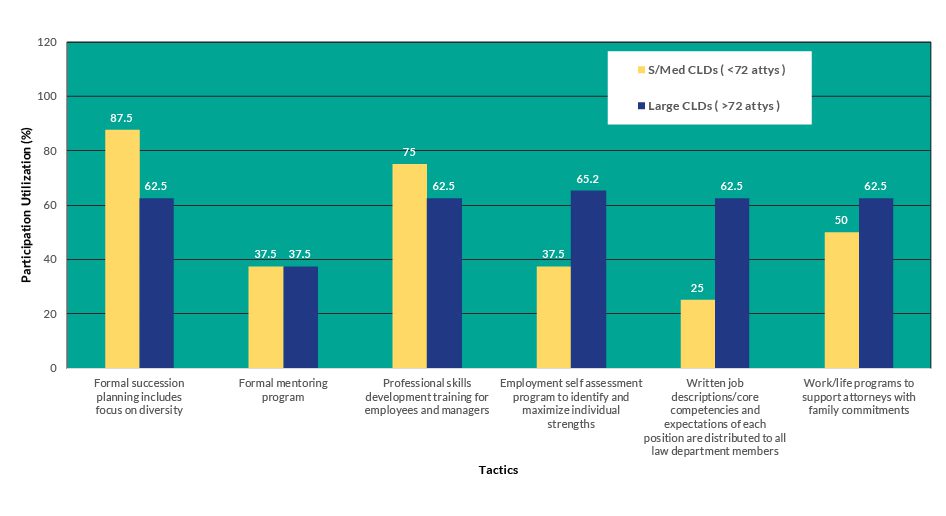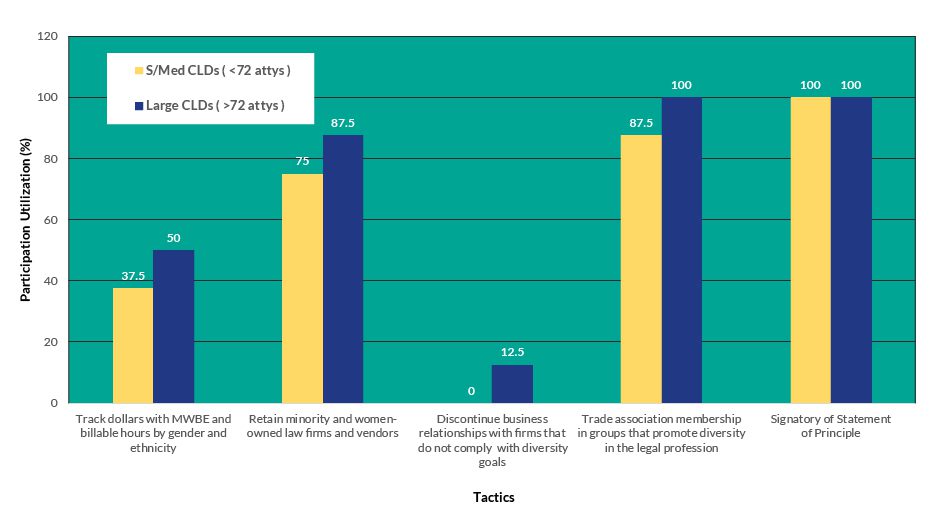Highlights of the “Creating Pathways to Diversity” Study
The following section presents the results of the Pathways Study in chart form, highlighting key findings culled from the 16 corporate law departments participating in the research project. Each chart identifies specific diversity activities undertaken by the participating law departments. Following Charts II through VI are the preliminary “Best Practices” compiled from an analysis of these key findings.
While Chart I reflects aggregate data for all 16 participants, Charts II-VI present aggregate data comparisons between large vs. small-to-medium departments. For the purpose of this analysis, “small-to-medium ” is defined as any corporate law department with less than 72 lawyers, and “large” being greater than 72 lawyers. The percentages noted in the charts represent the level of participation in each category compared to the total participation.
Chart I presents the 11 enumerated “Diversity Initiatives” identified as having been undertaken by the participants. Eight of the 11 categories reflect participation in the activities at a rate of 50 percent or higher. According to the study, the highest-ranking categories are:
- Reports reviewed by senior management (100 percent);
- Strategic plan includes diversity initiatives (94 percent);
- Participation in minority bar association events (88 percent); and
- Diversity awareness training (88 percent).
Those activities ranking just above mid-range level are:
- Culture and environment surveys (69 percent); and
- Professional skills development training (69 percent).
The lowest levels of participation are:
- Law student internship/clerkship (50 percent);
- Track dollars spent with Minority and Women-owned Business Enterprises (MWBE) and billable hours by gender and ethnicity (50 percent); and
- 360-degree feedback* (25 percent).
*The process in which an employee evaluates him or herself on a set of criteria, and the manager evaluates the employee, as do peers and direct reports. The employee receives a gap analysis between how the employee perceives him or herself and how others perceive the employee. Effective 360-degree feedback processes also include development, planning, and coaching sessions.
Charts II-VI:
Small-to-Medium vs. Large Corporate Law Departments
Prevailing thought within the corporate law community holds that, the larger the law department, the greater the resources that can be devoted to diversity initiatives and, therefore, the more successful the efforts. The data from the Pathways Study was analyzed to contrast diversity initiatives of “small-to-medium” corporate law departments with those of “large” departments.*
The following charts do just that, comparing the progress of this study’s small-to-medium and large departments in five identified areas:
- Commitment from Senior Management
- Diversity Initiatives
- Recruitment Tactics
- Career Development
- External Diversity
*The law departments in this study were divided in half by their number of lawyers, 50 percent being under 72 lawyers and 50 percent being more than 72 lawyers.
Chart II
Commitment from Senior Management
As the above chart graphically depicts, activities falling under the category of “Commitment from Senior Management” are quite similar between small-to-medium and large legal departments. In each instance, the percentages are high and comparatively close. The exception to the matched responses is “Board of Directors involvement” in the diversity process; a sizeable chasm exists between small-to-medium and large corporate law departments, with a 75 percent participation rate for the former and 12.5 percent for the latter.
Best Practices of Senior Management Involvement
- At three companies, the board of directors is directly involved in review of diversity initiatives, including the diversity plan.
Chart III
Comparison of Diversity Initiatives in Small-to-Medium and Large Corporate Law Departments
In contrast to Chart I, which examines diversity initiatives identified as having been undertaken by all participants, Chart III presents a comparison of seven select initiatives as pursued in both small-to-medium and large corporate law departments. Five of the seven categories reflect participation in the activities at a rate of 50 percent or higher, with “strategic plan includes diversity” ranking highest (87.5 percent for small-to-medium law departments, 100 percent for large). Three initiatives display an equal rate of program utilization between small-to-medium and large departments (managers compensation, 75 percent; mentoring program, 37.5 percent; and track dollars, 50 percent). The lowest level of participation-and the greatest disparity between small-to-medium and large departments-occurs in the 360-degree feedback initiative, with three times the number of large departments (37.5 percent) participating as opposed to small-to-medium departments (12.5 percent).
Best Practices for Measuring Initiatives
- One participant reported a process by which each business unit’s results go to a diversity center that uses a scorecard to analyze the results. The results go to the board of directors and the chief executive officer.
- Another law department routinely monitors pay practices, to ensure they are fair and equitable relative to race and gender.
- Other participants reported the use of employee surveys to help identify gaps between policy and practice.
Chart IV
Recruitment Tactics
Recruitment of talented minority attorneys is a fundamental aspect of any diversity initiative. Traditional channels include executive search firms or recruiters who scour the market to produce the candidates who fit not only the job description but also who will mix well with the culture of the organization. Diverse corporate law departments have utilized several nontraditional tactics to successfully attract minority and women candidates such as: scholarships for minority law students; summer internship programs to expose law students to in-house counsel administration and legal practices; and an employee referral bonus for current members of the law department who refer someone that is subsequently hired.
The majority of study participants reported having highly developed, sophisticated recruiting programs that identify candidates and make excellent use of traditional methods of recruitment, from tapping into bar association resources to holding legal “job fairs” and beyond. The lowest level of participation appeared in the “referral bonus for new hires” process, with utilization at only 12.5 percent for both large and small-to-medium law departments. Next in line in terms of low participation is “law student internship,” with both small-to-medium and large law departments coming in at 50 percent. Many study participants reported that they do not hire directly out of college, which could account for this lower rate of participation.
Best Practices for Recruitment
- One survey participant found that staffing needs were met through strategic staffing initiatives that require search firms to target candidates based on skill requirements consistent with internal needs.
- Another participant’s strategic staffing initiative is designed to identify women and minorities based on openings in specific functional areas-tax, litigation, patent & trademarks. Moreover, the variable compensation of managers is linked to meeting recruitment goals.
- Two companies have a formalized process whereby minority attorneys network with historically black colleges and universities, as well as with bar associations, at job fairs and other events.
- Similarly, another study participant reported that each business unit of the company has adopted a historically black college or university and develops close relationships with students by presenting seminars, speaking at campus events and donating equipment.
- Another participant reported recruiting graduates directly from law school, facilitated by establishing a strong presence at historically black colleges and universities.
- Yet another participant has developed a strong relationship with Howard University-a historically black university-and has taken on a number of summer interns. Some of the internships have resulted in hires.
Chart V
Career Development
Career Development activities have the lowest participation rates of all five categories. Formal mentoring is low for both small-to-medium and large corporate law departments at 37.5 percent. For "employee self-assessment," small-to-medium departments participate at 37.5 percent and large departments at 62.5 percent. Similarly, in the "written job descriptions" category, small-to-medium departments report a utilization rate of 25 percent, while large departments are at 62.5 percent.
Best Practices for Career Development/Retention
- One participant described a program in place for women and minorities that focuses on enhancing professional skills development. Seminars conducted under the program aim at teaching proven, concrete techniques to maximize performance and productivity. More broadly, the program is designed to build skills that allow all people to be included in the essential business of the organization, as well as to continue to foster an environment that supports the growth and development of everyone.
Work/Life Programs
- One study participant reported having established a program that provides managers and employees guidance to create alternative work schedules.
- Another participant engages in an ongoing review of polices to ensure that they align with the philosophies of an inclusive environment.
- One corporate law department is piloting a multi-faceted program aimed at establishing alternative work arrangements and providing better tools for employees for workplace flexibility.
Training
- In one law department, all employees are required to participate in a full-day inclusion workshop. The workshop focuses on skills to foster awareness of inclusion.
- One participant sponsors a "Workplace Communications" seminar for all employees that introduces and facilitates dialogue about gender-based communications patterns.
Chart VI
External Diversity
External diversity activities among corporate law departments vary greatly in their level of utilization, from an absolute high of 100 percent participation on the part of both small-to-medium and large departments as "Signatories to the Statement of Principle,"* to an absolute low of zero percent participation of small-to-medium departments (12.5 percent for large law departments) in the category of "discontinue business relationships with firms that do not comply with diversity goals." Moreover, less than half of small-to-medium departments (37.5 percent) "track billable hours by gender and ethnicity", while exactly half (50 percent) of large corporate law departments report participating in that external diversity activity.
Best Practices for External Diversity
- Two participants have sophisticated programs to track MWBE dollars and billable hours by ethnicity and gender.
- Another participant has adopted the philosophy that "minority and female partners will have a place at the starting line" in competing for the company's business.
- One participant has developed sophisticated metrics to track and monitor diversity success, particularly tracking MWBE utilization and vendor diversity efforts. Those vendors that are approved become "preferred vendors".
Inclusion Initiatives
- Another participant stresses a cultural strategy that encourages practices and actions that provide a strong, supportive environment where everyone feels valued and a vital part of corporate activities.
*The Diversity In the Workplace: Statement of Principle was originally drafted and circulated by Charles Morgan, executive vice president and general counsel at BellSouth, to general counsel in major U.S. corporations who have pledged to encourage law firms to increase diversity among their legal staff. Currently, 300 general counsel have signed the Statement of Principle, representing $30 billion in purchasing power. For more information about the Statement of Principle, visit MCCA's Website: www.mcca.com.






